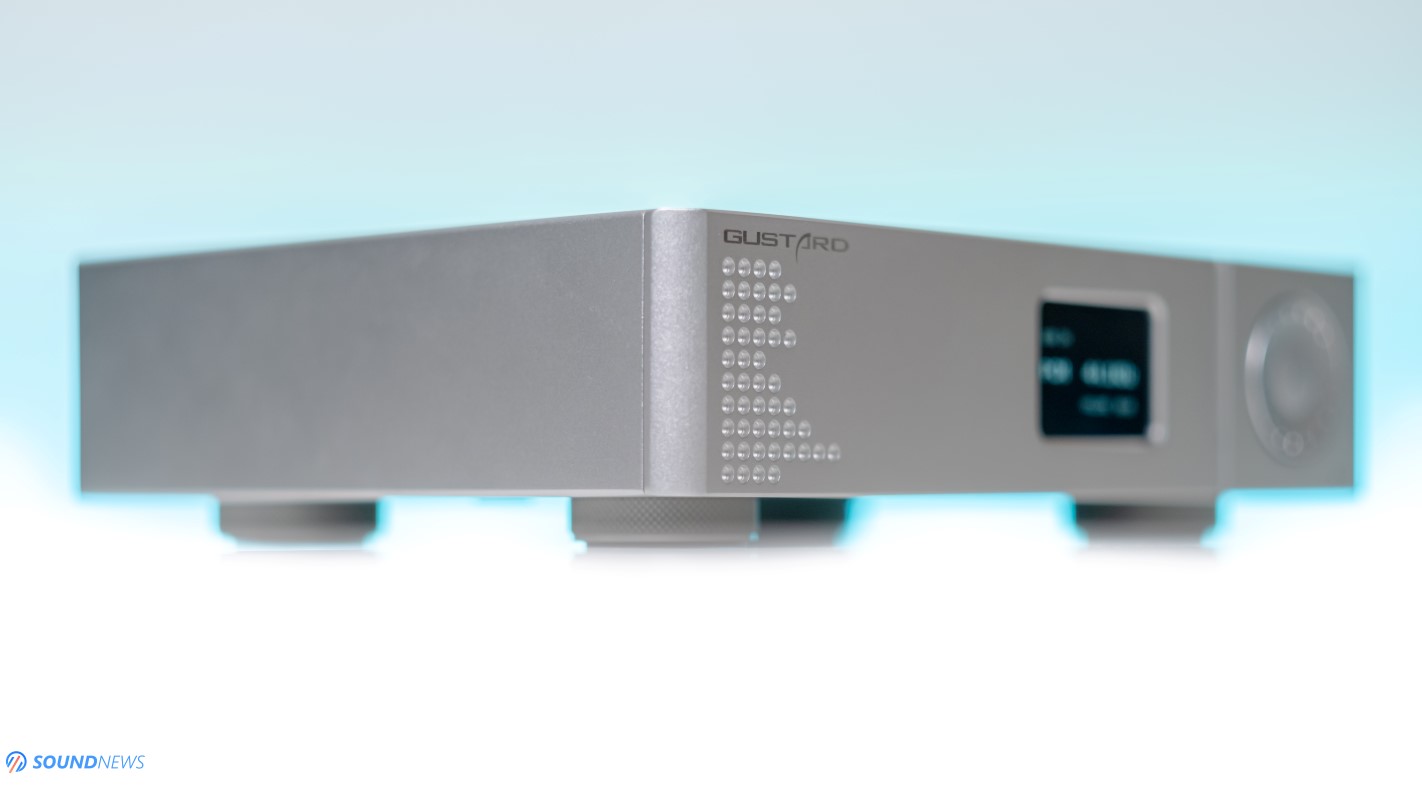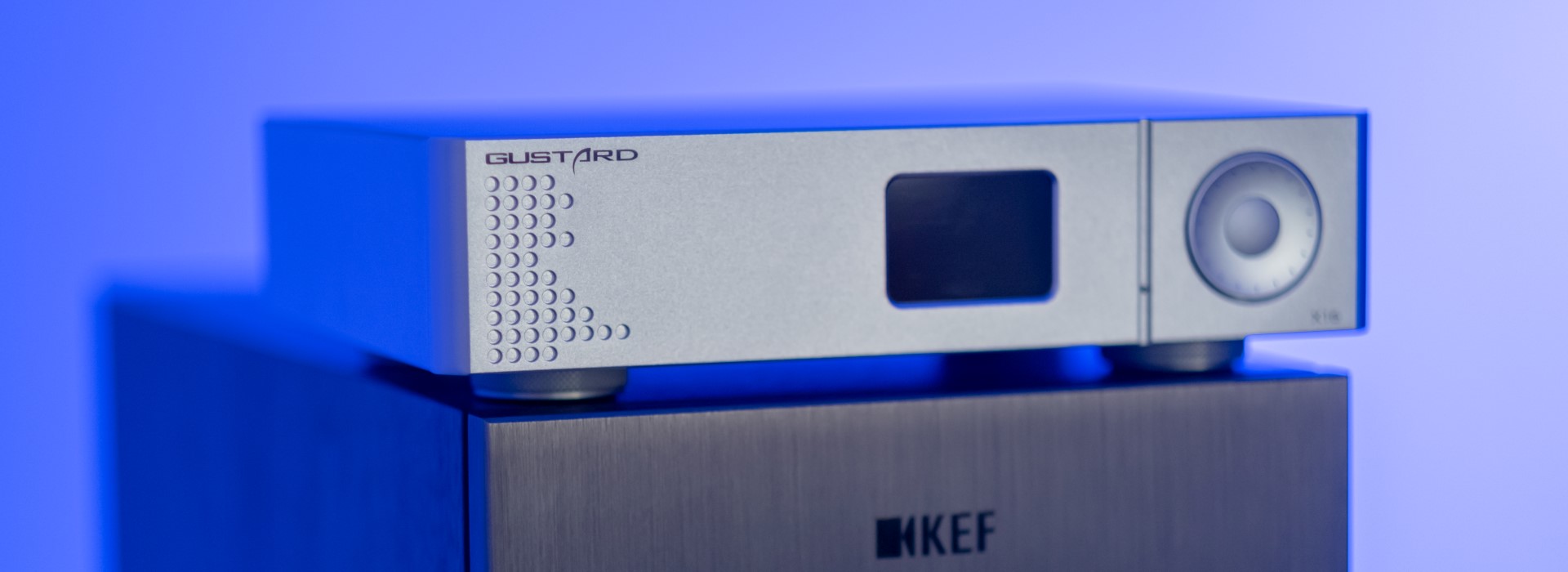
My Video Review:
Gustard proved multiple times that good digital audio runs through their veins. X26 PRO was a huge surprise that I didn’t see coming, outperforming pretty much every oversampling delta/sigma DAC I’ve tried at my place…except for one unit that I’m using for quite some time now. The more I was listening to their older units like A22 and A18 DACs, it became clearer that Gustard has everything they need to succeed.
Still, roses aren’t red and violets aren’t exactly blue for Gustard, as they are struggling with the Western market. Their website needs a lot of polish, the MiniCDs bundled with their units should be banned for good, their user manuals should be seriously improved and there is much work to do when it comes to product design. Seriously now, who came with an idea misaligning the screens of X16 and H16 units, using different screen sizes, fonts, screen colors and brightness levels for two products that are supposed to work together as a team…In my eyes, Gustard looks more like an engineering-oriented company, than like a design oriented one. The smallest details are still making the biggest splashes and, in their stead, I will be thinking twice before releasing a new product.
However, they are still great when it comes to digital audio, their X16 DAC that I’ll be testing today is a road opener in many ways, it’s the first converter to use the newest ESS 9068AS DAC chips that have a full MQA decoder built-in. On paper, X16 seems like a high-performance modern DAC, wrapped in a fairly small aluminum enclosure with just a mid-fi price tag attached to it. Could this be the Holy Grail of digital audio, or this is this another flavor of the month? Let’s find out together.
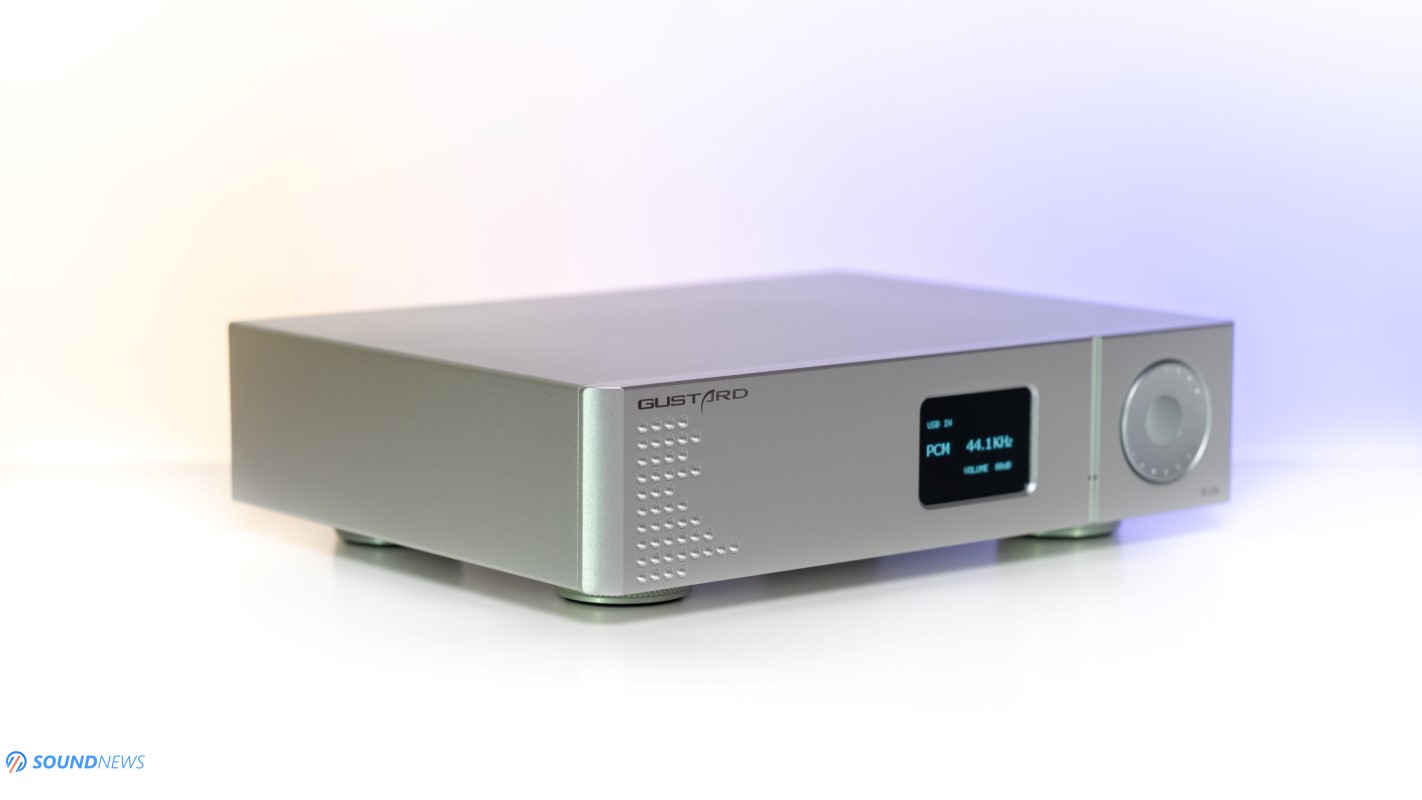
Unboxing & Package Contents
X16 came double boxed and that’s already common practice for all units coming from Asia. The product box is moderately sized, but quite heavy, already telling that I will be dealing with a nicer DAC. X16 was wrapped with a big blanket for some additional protection, while the rest of the accessories are staying in their own foam pockets. All Gustard units came with the nicest USB cables and X16 isn’t an exception to that rule. It is gold plated and thicker compared to usual no-name USB cables, Power Sync made this one and I like it already. You can also find a power cable in the package, a Gustard warranty card, the same remote control I’ve seen with their bigger units and of course a MiniCD… I have already voiced my point of view multiple times about that one so I won’t repeat myself. There isn’t a single paper in the package, a spec sheet or some basic operation instructions, nothing like that. If you need its USB driver, here is a direct download link and here is its user manual.
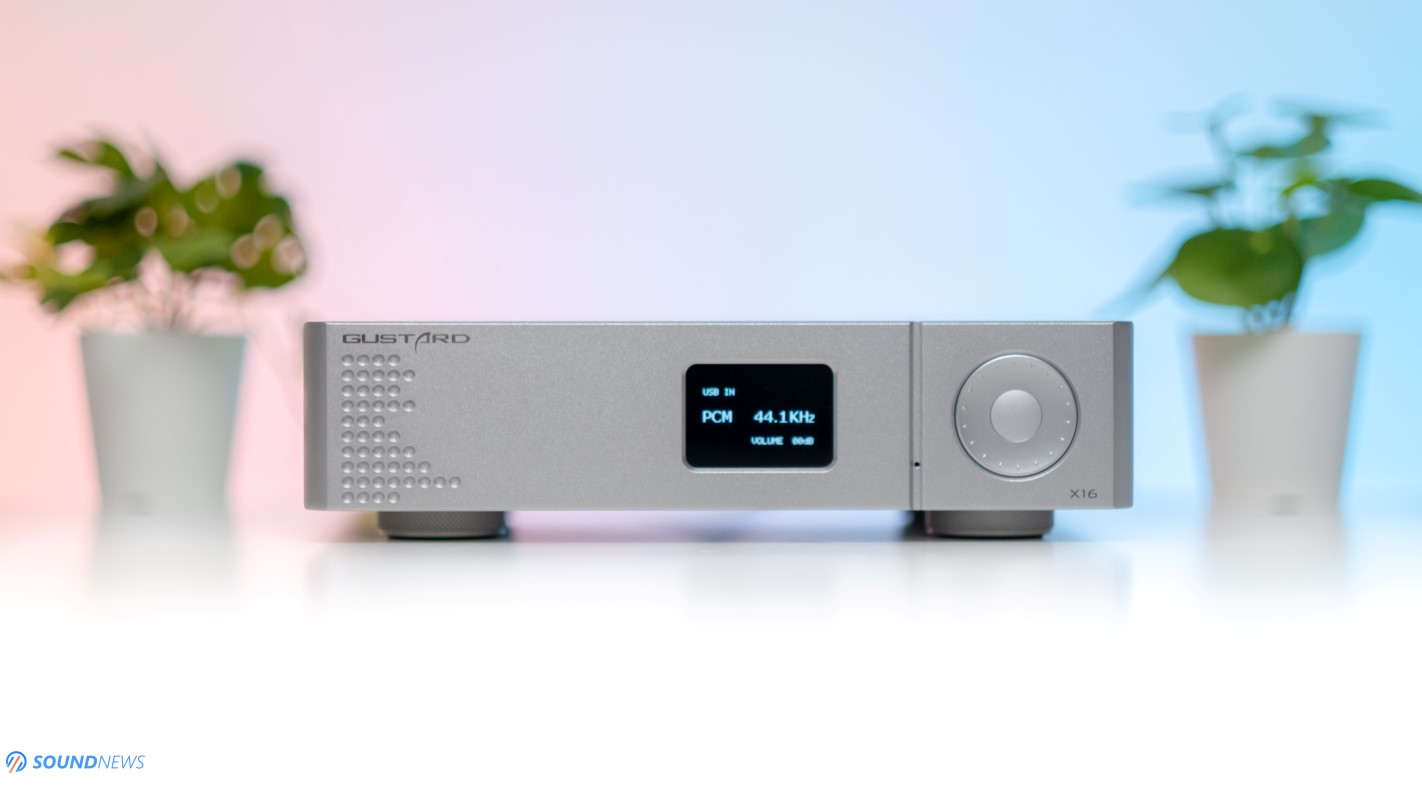
Design & Build Quality
X16 has pretty much the same metal case of their A18 DAC that I’ve tested some time ago. It also looks like a miniature version to their A22 and X26 PRO units. I see a fully CNC-ed piece of aluminum, with just a thick front and back plate attached to it.
Again, there isn’t a single visible screw on this one, only on its back. It is painted in matte silver and you can have it in matte black if you please. It looks plain and simple, but it’s seems to be well-built. I’m glad to see the best aluminum feet in the business, the exact same ones I’ve seen on all their bigger units. Gustard didn’t spare pennies building its case, it screams high quality from any point of view. I like that it follows the same design language of Gustard audio components, that nice volume wheel on the right and the small OLED screen in the middle is so…Gustard. Surprisingly, it also has the same width with the Topping D90 and M400 from SMSL and it is about the same width with the Benchmark HPA4. These two are looking really nicely together, they worked as a team for about a week now and I feel that I’m ready to talk about its sound quality.
Its side plates are rounded and the front plate is rounded at the edges, I’m swapping electronics on a daily basis be it amplifiers or DACs and sometimes they might touch each other. With rounded cases, I’m more confident that I’m not going to see scratches or dents anytime soon.
At about 2.5 kilos or 5.5 pounds, it is considerably heavier than its competition like the Topping D70S, D90 and SMSL M400. I have a bigger confidence in heavier devices and if we are talking about DACs, a heavy unit equals with a nice linear power supply and with a bigger capacitance for power storing and filtering.
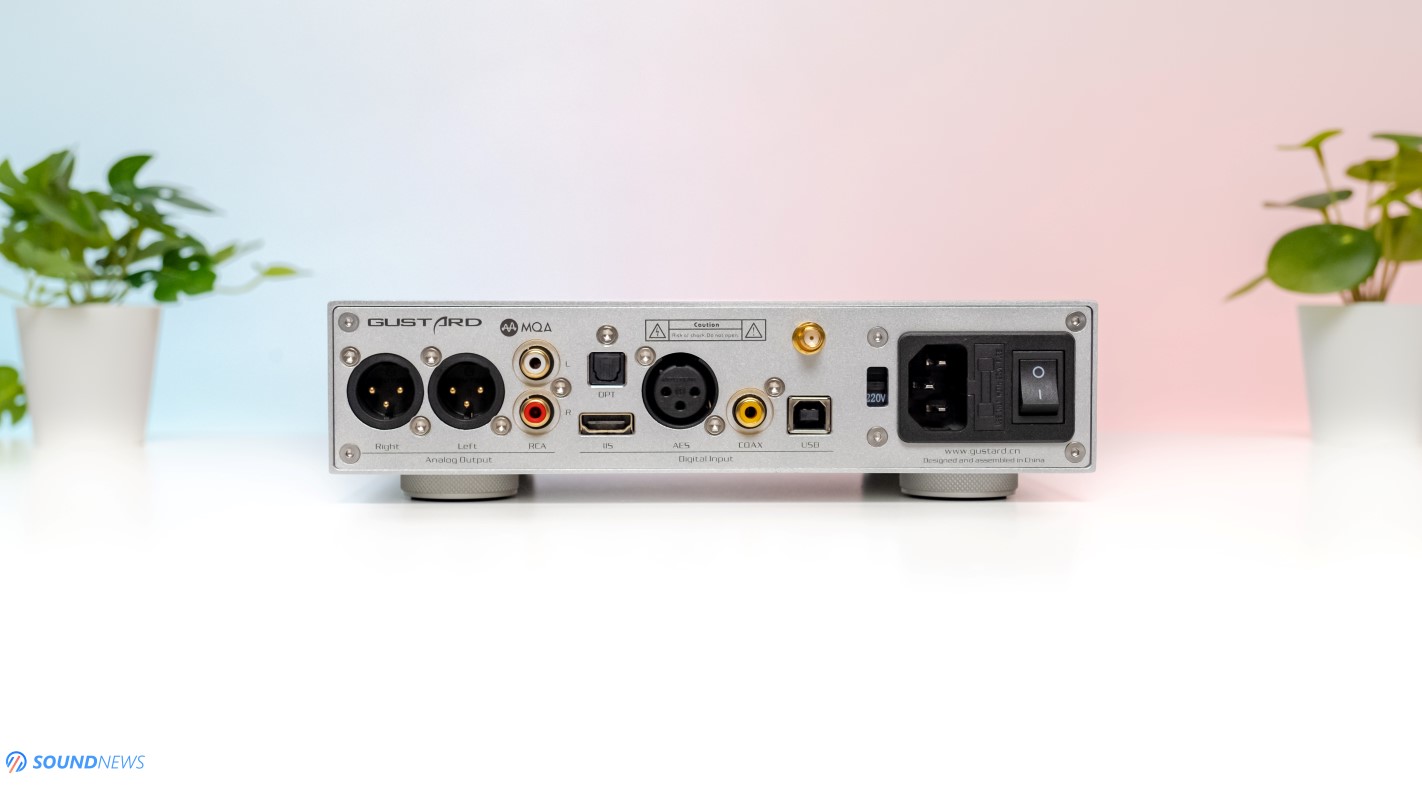
Controls & Connectivity
X16 has a clean front panel with just a simple monochrome OLED screen in the middle and a nice volume wheel on the far right. If you want to use it in the DAC mode, select maximum volume of 0 dB and if you will be using it as a DAC and Preamp, you can choose the desired volume level via that remote control or via its volume wheel. In the middle of the volume wheel a button is located, a short press on it will select your desired digital input and a long press will engage its user menu, where additional setting can be found. Gustard is not forcing you to use the remote control in case you’ll want to change setting like digital filters, you can do that single-handedly, unlike Topping that is forcing to use its remote for advanced settings.
On its back you can spot a wide variety of digital inputs as: USB, I2S, Optical, Coaxial and AES. Do note that USB and I2S are the only inputs that will decode natively DSD material or PCM up to 32-bit 768 kHz. It is a fully-balanced DAC, so it offers XLR and RCA outputs, a 110V or 220V voltage switch, there is also a Bluetooth antenna socket, an AC inlet and an On/Off switch.
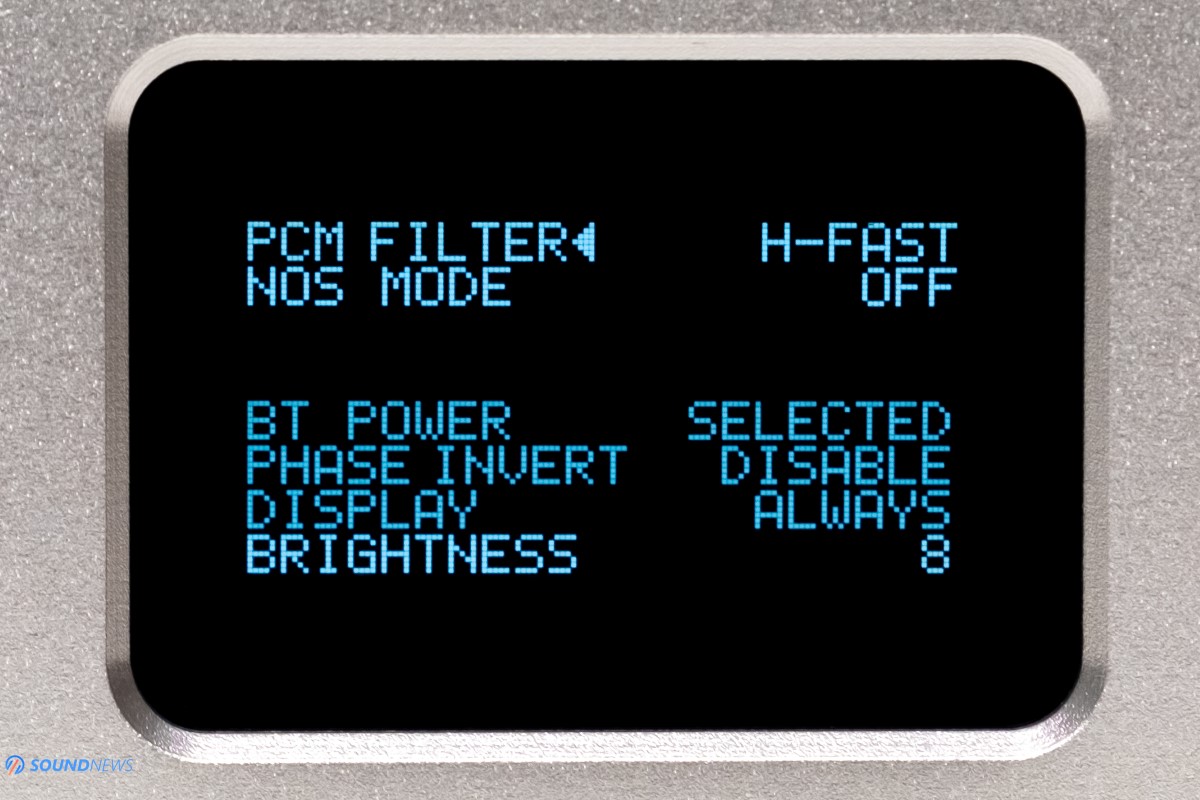
Menu Settings
You can access its user menu by pressing the Menu button on the remote or by a long press on the button to the far right. Once you do that, a user menu like this will appear:
- PCM Filter: 3 positions. Those filters will be altering the FR past 20 kHz. If you want the fastest treble roll-off, go with H-FAST and if you want the most extended treble response go with M-SLOW. Subjectively, I can’t spot a difference between them, since I don’t possess super-human hearing past 20 kHz.
- NOS MODE: 2 positions. ON or OFF. In its OFF position, it will work as a regular oversampling DAC and on its ON position, there is no digital oversampling, acting as an old-school Non-Over-Sampling DAC (NOS). If you want a smoother top end and a warmer sound, then enable its NOS mode
- BT Power: SELECTED or ALWAYS. Self-explanatory, leave it at Selected if you are not using the BT input that often.
- Phase Invert – 2 positions, DISABLE or ENABLE. Self-explanatory, leave it at disabled.
- Display – 2 positions, ALWAYS or AUTO OFF. If it bothers you that much, leave it at Auto Off. I’m leaving it at Always, so I can check the sample rate and the volume level at all times.
- Brightness: has 8 brightness positions, none of them is completely dimming its display. The lowest position worked great at night though.
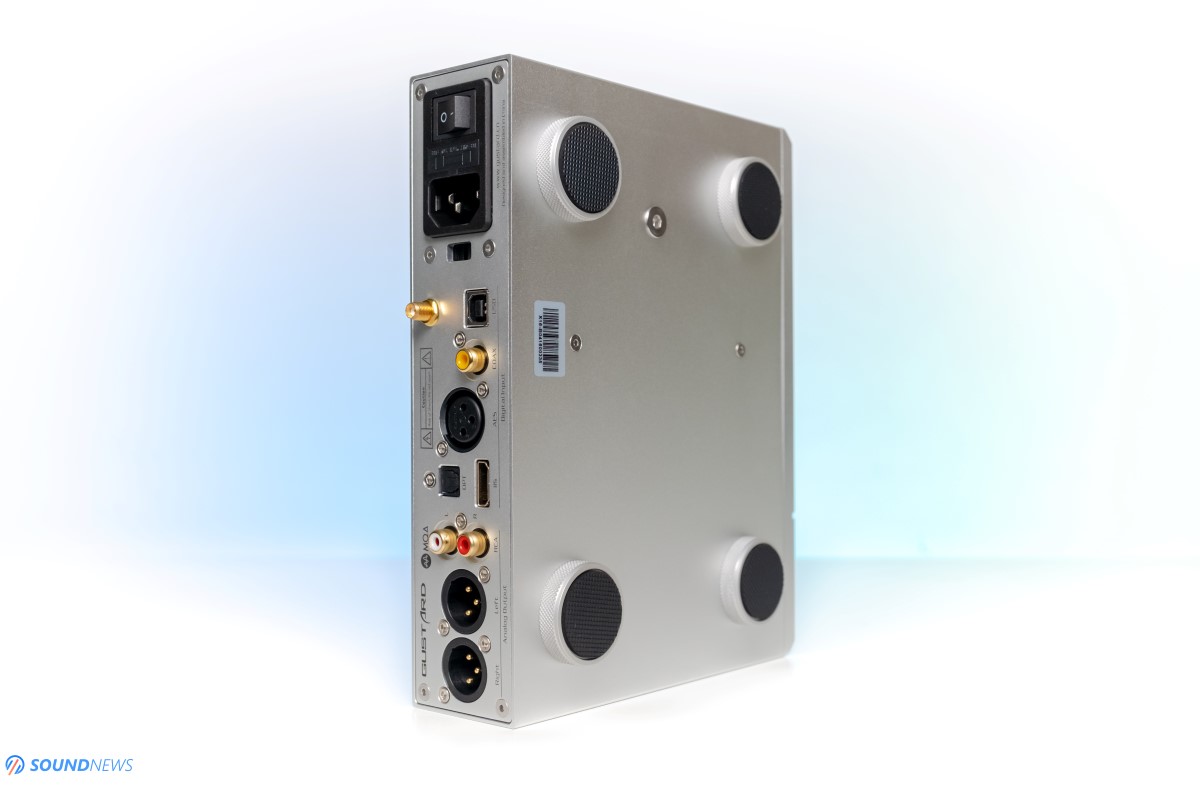
Tech Inside X16
The biggest novelty is that Gustard went with brand new DAC chips, more exactly with two ES9068AS DAC chips of ESS Technologies, but please don’t get confused by the naming scheme, as those aren’t any better to their flagship 9038 PRO. I see them as the next generation to their extremely popular low-voltage 9038Q2M mobile chips. In theory a single chip will be needed for a true balanced signal, since it’s a quad-channel DAC, but Gustard used two units to further increase its dynamic range and lower the biggest enemy of headphone setups: channel crosstalk. The most interesting thing is that ES9068AS incorporates a full blown MQA decoder. It means that additional electronics are no longer needed to fully decode MQA files. This way the signal with be shorter and X16 should lock on those files by a hair faster to traditional MQA enabled DACs. I’ll be testing this myself so stay tuned for that. So far, this is the cheapest MQA capable DAC of Gustard that should be making plenty of competition to Topping D70S and SMSL M500 V2.
AS9068 is a current output chip, meaning that a current to voltage conversion (I/V) stage will be needed. Thankfully Gustard went with warmer and more natural sounding OPA1612 op-amps, instead of the regular LEM49860 they are using in A18 and A22 DACs. OPA’s are working much better with ESS chipsets and Gustard seems to be on the right path with them.
Gustard was plenty of experience with Altera MAX II FPGA used for PLL shaping, clock management and DOP modulation and the same super precise femto-second clocks from Accusilicon AS318-B can be found in here too. As a side note, A18 and A22 which are more expensive are using them too.
The power supply and filtering are on pretty high level, a linear and regulated toroidal transformer will be doing the cleaning service and several voltage regulators will be taking that power, will be lowering the noise floor even more, offering back a much cleaner power to the critical analog and digital circuitry.
Gustard used the most advanced Bluetooth chipset on the market, the notorious CSR8675 that supports all the best Bluetooth codecs as LDAC, AptX, AptX-HD, AptX-LL, AAC and SBC. Add the latest version 5.0 and you can be sure that BT signal will be strong. Its Bluetooth antenna on the back is working as a signal booster and I will be testing its range very soon.
You can also spot the best USB input chip from XMOS, the famous XU216 that supports all the highest sampling rates as 32bit 768 kHz PCM, DSD512 and MQA files.
The is just one thing I dislike about it, but it is mostly nitpicking from my part. Gustard lowered its voltage output from 6V as it was on A18 and A22, to 5V on X26 PRO and back to the industry standard 4V on X16 on its XLR outputs. It isn’t exactly a con, but a higher voltage output works nicer with power amplifiers and several headphone amps are also liking a higher voltage intake. For example, the true potential of SMSL M400 THX-AAA amplifier can be achieved only with a 5.5V signal input. A18 and A22 can do that, X16 can’t…
Test Equipment
I tested it in a high-end loudspeaker setup and also in several headphone setups. When I used it in the living room, I’ve tried it as a DAC + Pre unit and then only as a DAC, leaving the preamp duties to the Topping Pre90 or to a Benchmark HPA4. I’ve used a Keces S300 power amplifier, that was driving a pair of KEF Reference 3.
In the headphone setup, it was mostly connected to the Benchmark HPA4 or to its soul mate: Gustard H16 balanced headphone amp driving several high-end planar-magnetic headphones and a bunch of dynamic headphones. Okay folks, enough with the talk, my ears are itching for some music, so let’s hit some ear-drums!
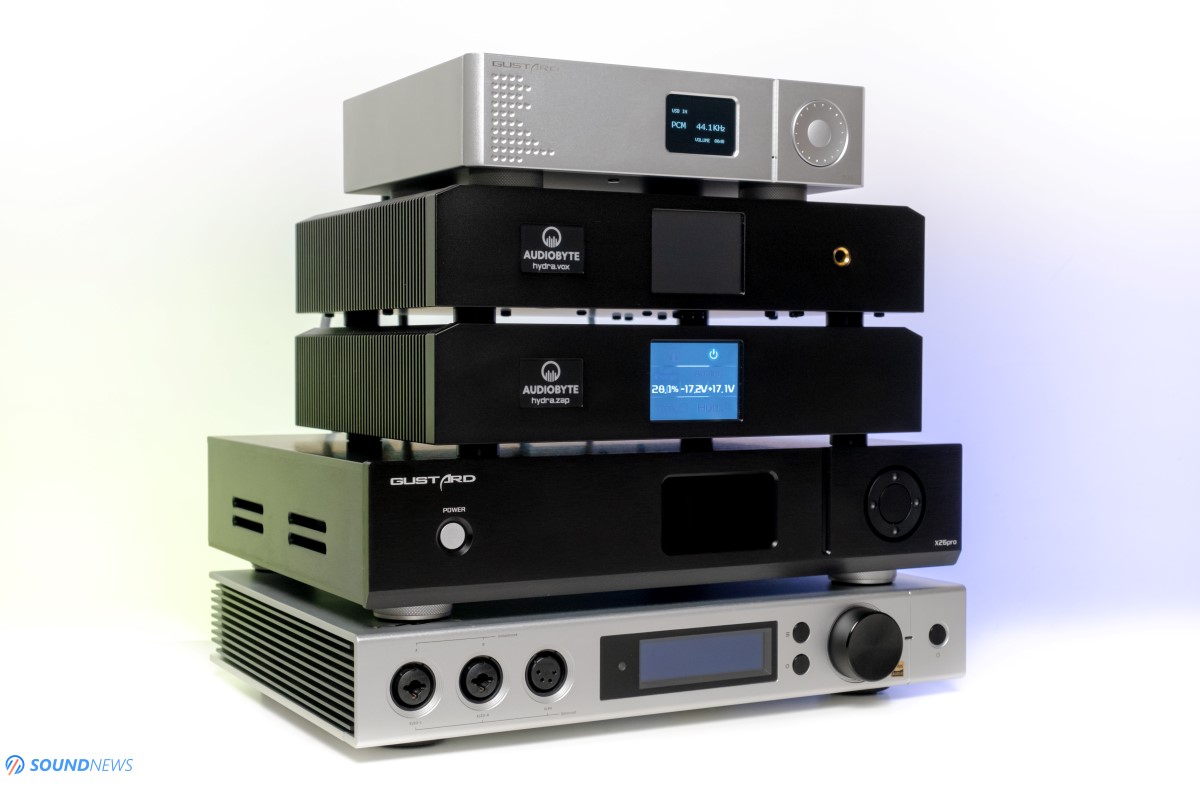
Sound Performance
I. Preliminary Impressions & Tonality
People put it in top of their rankings and hailed it sky high as The One to beat from now on. While I don’t possess super human hearing or expensive audio analyzers, I am actually listening to the gear I’m reviewing with my own measuring _apparatus_es and those are my ears. In the end, we are listening to music with our own ears and not with some third-party devices. We love getting goose bumps, we love butterflies in our stomachs, we love toe taps, head bangs and those are obvious signs that something is clicking into place. I have the X16 for more than a month now and I’m listening to it for more than 30 days in several high-end setups and I’m sure that I’ve squeezed the best it could possibly offer.
The DACMan himself will give you that it’s a very detailed, transparent and noise-less sounding DAC, it is extremely clean sounding, easily fighting with some of the nicest units I’ve tried. However, when it comes to transmitting emotions while listening to music, when it comes to midrange presence, naturalness, warmth, layering, texture, soundstage, depth and bass slam, X16 doesn’t stand a chance versus their own X26 PRO, versus Matrix Audio Element X and X-Sabre Pro units and versus some other units.
Don’t get me wrong, X16 is a still a good sounding unit, just not on the same level with the best units I’ve tried. I’m still getting a nice bass response, there is a decent midrange rendition, without going overboard to the overly warm and smooth camp. Its treble seems to be extended in the top octave, there is a lot of shimmering, without the grittiness and treble itch of their A18 and A22 DACs. Surprisingly, the ESS equipped X16 is less harsh sounding to the AKM based A18 and A22 DACs and I’m still rating it quite highly. In my view, X16 just outperformed units like Soncoz SGD1, SMSL SU-9 when it comes to detail retrieval and feature set, it is definitely a little cleaner sounding, it seems more transparent with high-end planar-magnetic headphones and there is just a glimpse of easiness and effortlessness borrowed from upper class audio equipment. MQA worked absolutely flawless, there isn’t a short delay to usual MQA equipped DACs, it locks on instantly and shows the correct sample rate. I was actually surprised by how clean and detailed it sounded, squeezing the last drop of information from my tunes.
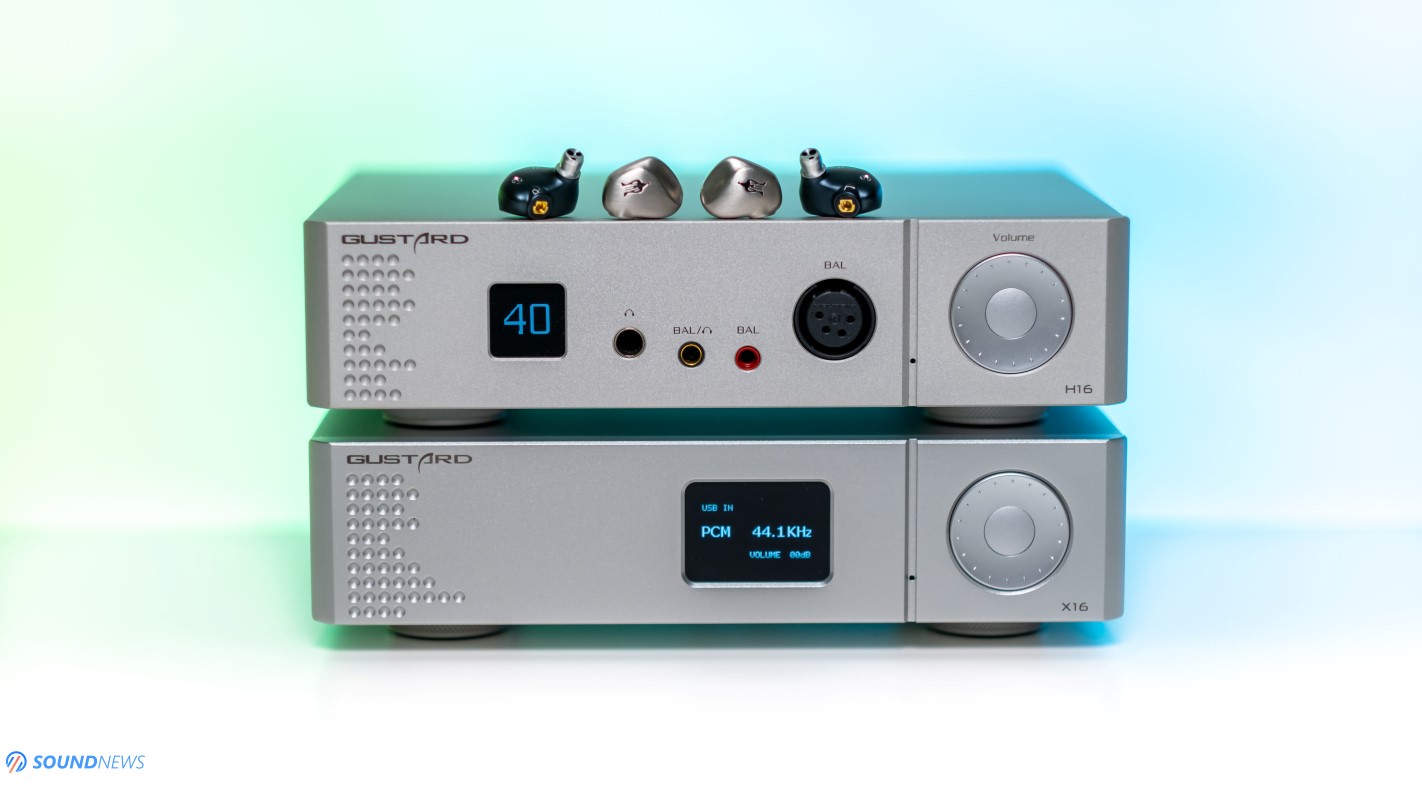
II. Noise Floor
This will be a very short chapter as pretty much all the newest DACs are already very impressive when it comes to repelling mains noise or any type of noise. I’ve added a Benchmark HPA4 into the chain, which is known to be noiseless with anything I’ve thrown at it, including ultra-sensitive IEMs. Connecting it to a Plixir Elite BAC400 passive power conditioner didn’t change its noise-floor as I couldn’t spot it in any configuration with a pair of IEMs. Putting it in my loudspeaker setup, adding a Topping PRE90 or a Benchmark HPA4 and then a KECES S300 power amplifier, again didn’t add any hiss into the mix. KEF’s UNI-Q drivers were dead silent even after approaching them closely.
Considering its decent capacitance, its linear toroidal transformer and voltage regulation, it seems that the extra care Gustard put in this unit paid off and I would be surprised hearing anything less than a noise-less performance. Adding a cell phone on top of it, didn’t add hum or hiss and all I’ve heard was a clean, undistorted sound that didn’t stay in front of the musical signal. Background was simply nowhere to be spotted, it was as black as night, there weren’t nasty gremlins playing at higher volumes, no grain, no hiss, nothing like that and no matter if I would be using headphones or speakers, I knew that I can rely on its clean and noiseless performance.
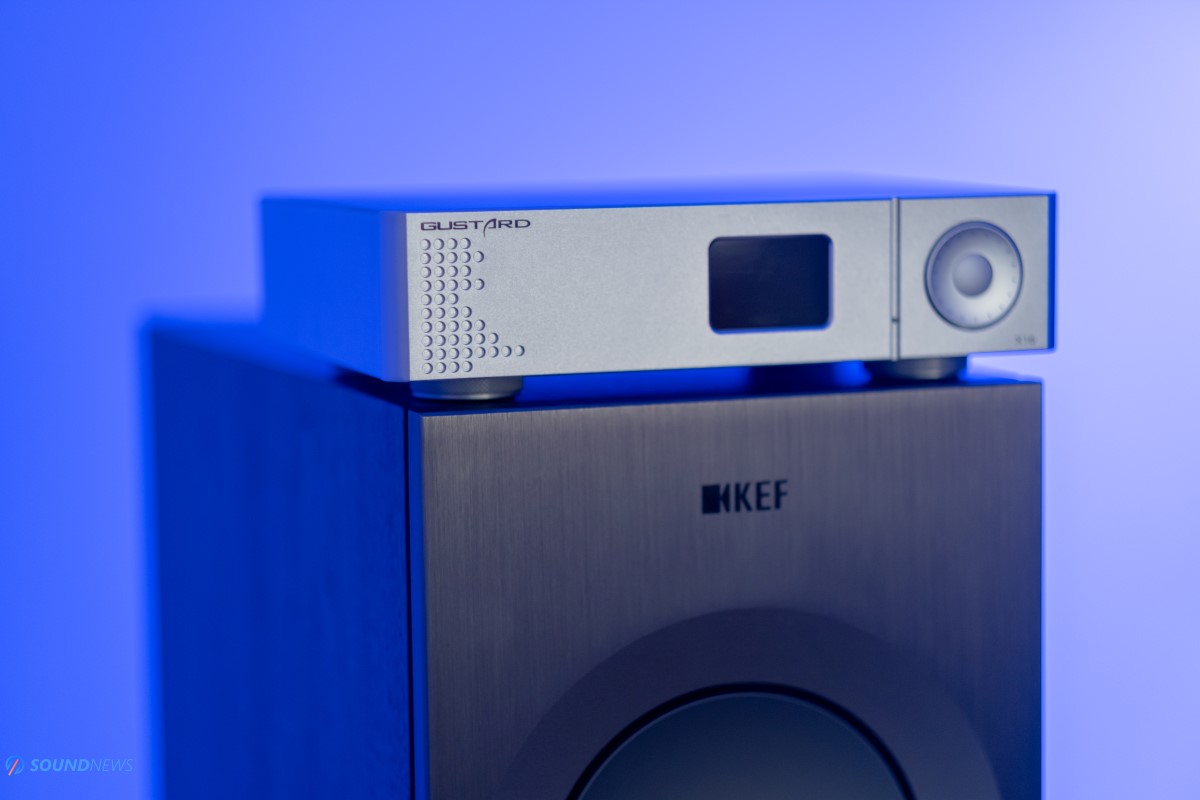
III. Transient Response
This is where X16 proved that a fast transient response can be achieved even with mid-level converters and generally speaking oversampling DAC are still the fastest sounding units, outperforming entry to mid-level R2R designs by a long shot. As you all know, transient response is a cumulus of two important factors: (1) speed and (2) slam. When it comes to speed, I am putting Laurus Nobilis on the forehead of X16 as it sounds pretty much as fast as their much more expensive X26 PRO DAC, as lighting fast as my own $3000 DAC, easily keeping up with the most demanding tunes. The only thing that slightly bothers me is that its slam isn’t that visceral compared higher tiered devices. With X26 PRO I was putting a pillow on my chest so it would hit me gentler from different angles in my loudspeaker setup, but with X16 I didn’t need to do that. There is still some bass slam, there is still impact, but it isn’t chest pounding and ruthless and if you are looking for a harder bass slam you just might look elsewhere.
In reality you can’t have them all in such a small and affordable package. I mean two op-amps at its output stage, a lower voltage output and only a decent capacitance can’t do miracles…X16 is only decent when it comes to bass slam and a far cry from the best I’ve tried. On the other hand, you can counterbalance the weaker slam by using class-A amplifiers or ones that use oversized power supplies and an overkill capacitance.
After adding the Flux Lab Acoustics FA-10 and the Burson Soloist 3X in my chain, X16 started having a meaner attitude, showing its clenched fists, its bass output became impactful and much heavier. Finally, I was hearing additional layers of bass information, sub-bass started moving more air down low and from a shy sounding DAC, X16 transformed into an experienced pugilist throwing harder punches left and right. Chest pounding bass notes returned back home, fully satisfying my electronic music needs.
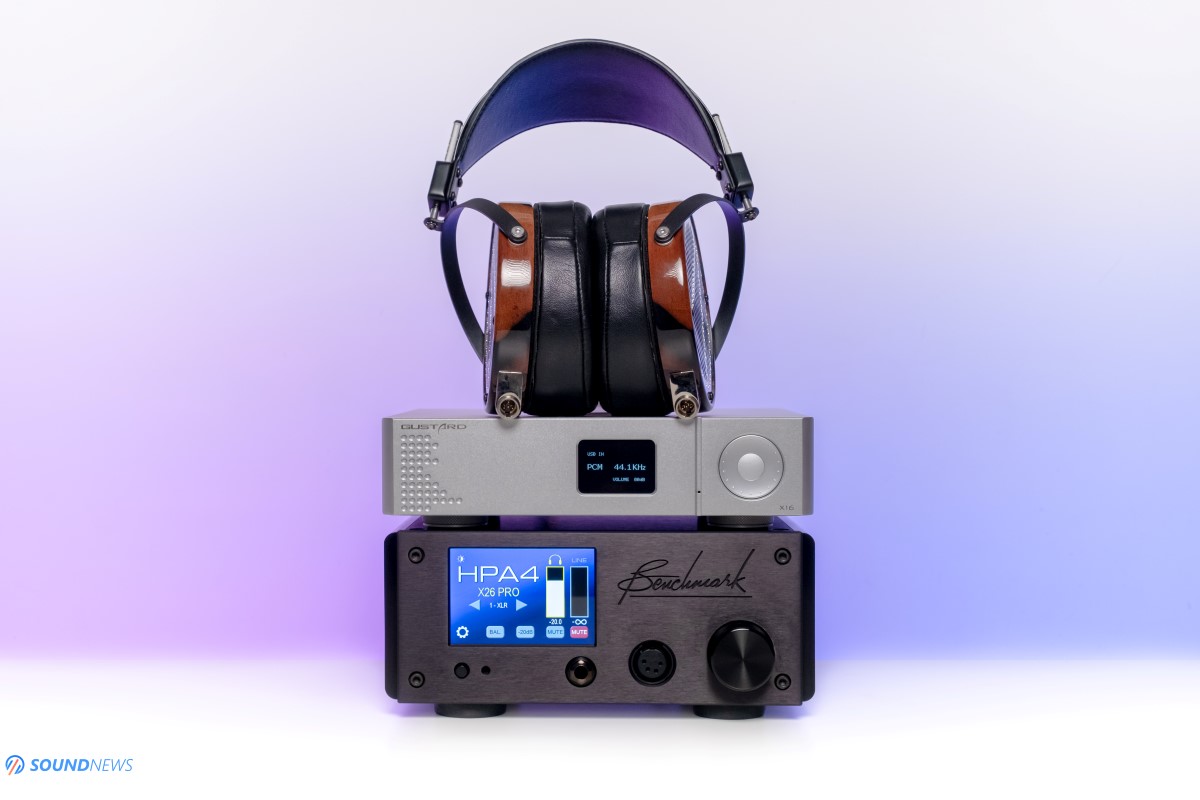
IV. Soundstage & Depth
Contrary to popular belief, ESS-Sabre DACs can also be impressive when it comes to soundstage, imaging and depth. A nice power filtering is probably the most important part, followed by a nice capacitance and then by a dual DAC configuration. Luckily, X16 has two DAC chips inside that increased the dynamic range and lowered the channel crosstalk. The last one is the worst enemy you can have in a headphone setup. There are many ESS-Sabre DACs that are sounding upfront and quite claustrophobic, from the most popular ones, Benchmark DAC3 and Mytek Brooklyn DAC+ were somewhat closed-in sounding in their stock forms. X16 is better is this regard, boosting the perception of air that is moving around and the pin point location seems to be more precise in well-mastered albums. X16 was almost great in here, it approached closely to some of the best converters, but it didn’t outperform them. Still, Echoes by Signum Saxophone Quartet (Qobuz / Tidal) sounded very layered, unearthing one layer after the other, everything was breathing nicely, there was plenty of air traveling in the room and the whole presentation felt detailed without excessive sharpness. I particularly enjoyed the second track, please give it a try, I don’t remember when Richter sounded so wide and open in my room. X16 was able to revitalize and calm my spirits, for no reason I was seeing myself surrounded by sun shine and tall gras, it was able to convey the message of the music. An amazing album, that was highly transparent and airy sounding, perfectly preserved by the little X16.
When I jumped to their X26 PRO, the images became bigger, like I was looking at a bigger TV that could render the full color gamut. X16 was almost there, leaving room for improvements. X26 PRO is 3 times more expensive and it shows when critically comparing both units. X16 is a good sounding DAC when it comes to stage size, spatial cues and depth information, but it’s not legendary. However, putting a preamp and some bigger amps after it, prepare for an expansive sound that is preserving the spatial cues and depth information.
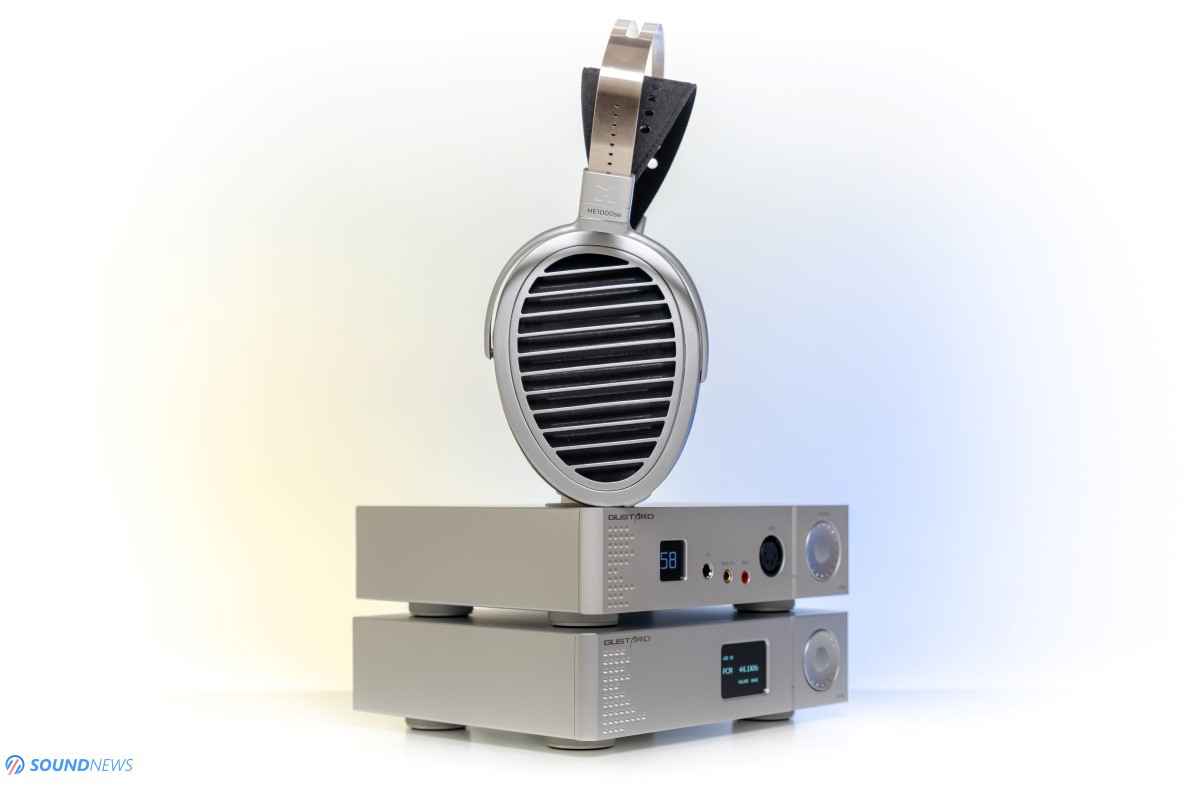
V. Resolution & Transparency
I have arrived at the culmination of what makes X16 a good DAC in the first place. Not a single amplifier, preamplifier, or power conditioner can make your music detailed, transparent and see-through, that is the sole job of a DAC, it is to blame or in this case to praise. The whole job of DAC is being right, correct and precise in its math. I know that a lot of people love sugar coated DACs that are adding some kind of flavor into the mix, those kinds of people are calling linear, extended and detailed sounding DACs as clinical. In my view, the DAC should be the truth teller, the law generator and indeed a lot of times the truth is not that easy to accept. After a few years, I’ve finally understood that I can always count on a DAC that is honest with me, that tells only the truth, that is detailed to its core and it seems that X16 goes exactly in this direction.
I personally don’t hold a lot of respect for forgiving sounding DACs, I personally value non-forgiving sources, that are giving me everything on a plate, it should be my only decision to look and hear all those micro-details, and mastering errors or not. I can count on X16 because it always appeared as detailed and transparent sounding no matter the song. It was so obvious hearing people inhaling and exhaling air in their lungs, fingers touching musical instruments, low-level notes and air casually passing around in well-mastered music.
I can give some musical examples, but I will be arriving at the same conclusion that X16 is incredibly detailed, transparent, it is noiseless and it will easily show the smallest details and nuances in your music. Prepare to hear not only the good, but all the bad, as X16 is unforgiving and if there is grain, hiss or random noises, you’ll hear them loud and clear.
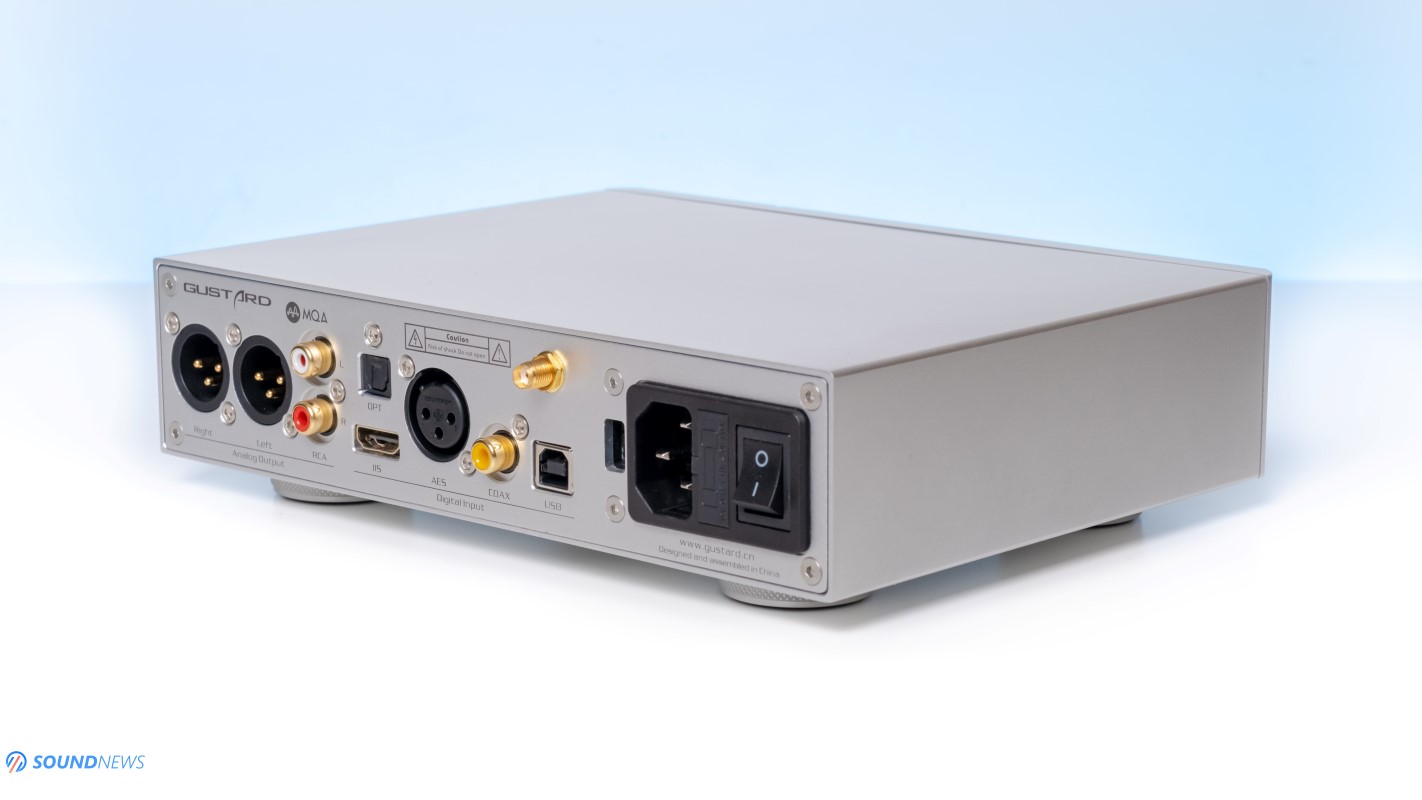
VI. Bluetooth Performance & MQA Experience
I will briefly go through this chapter and will just remind you that it uses the best Bluetooth chipset of the moment, that supports all the nicest Bluetooth codecs, plus it is Bluetooth 5.0 enabled. It uses a Bluetooth antenna, that is familiar to the ones I’ve seen on former Topping, SMSL and Gustard units. Its antenna works as a Bluetooth signal booster. Without too much fanfare, I’ll just tell you that it has a rock-solid Bluetooth performance, several concrete walls didn’t pose a problem for it, even from a substantial distance. About ~10 meters away the signal was still going strong and only I moved to the balcony, with 4 concrete walls in between, it started stuttering, losing some beats here and there. In an open space, I’ve tried as hard as I could, but I never lost its signal. Topping and SMSL already had a rock-solid Bluetooth performance and X16 performs pretty much the same.
Sending music from a smartphone via streaming services as Qobuz and Tidal worked as a charm and LDAC codec sounded almost indistinguishable to its wired connection. Bottom line is that X16 performed very good in here, exactly as good as their top of the line X26 PRO.
Its MQA decoder works as intended, it locks on slightly faster to my own DAC or to their X26 PRO, it shows the correct sample rate on its screen and seems to be working excellent. If you are streaming a lot of music as I do, it looks to be one of the most affordable MQA capable DAC on the market right now. I am an avid Tidal Hi-Fi user, I use it daily as it helps discovering new music and it reminds me if a favorite band releases new stuff, it’s pretty cool.
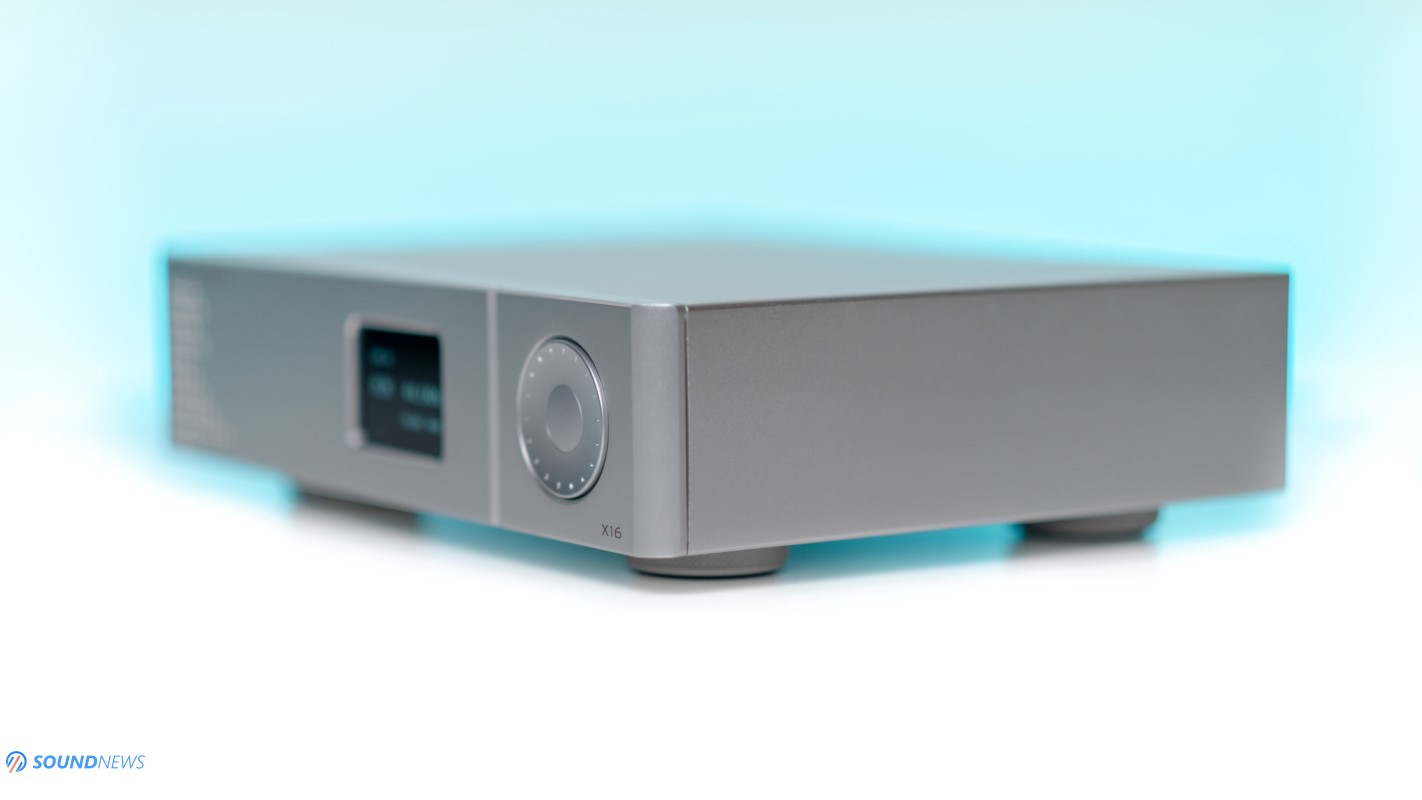
VII. Frequency Response
A. Bass
X16 presented a very clean, transparent, airy, almost ethereal bass performance. There isn’t any kind of distortion down low, air is moving freely around and it’s a fast type of bass. It was more than enough in my tunes, only sometimes I wanted better body slams and a higher impact like their X26 PRO was providing. It easily reached the lowest pits, it had a faster decay, so forget about a broken subwoofer like performance. I liked it when it comes to quality, I just wanted a higher quantity and a better presence in my tunes. Sometimes it felt strained and shy, opposed to what I was hearing from their X26 PRO. If you want a nicer presence and a nicer slam, just use a nicer amplifier (ideally a Class-A amp) and you’re ready to rock.
B. Midrange
If you expect a mellow, smooth and organic midrange, then I’m going to disappoint you. There is still some meat to the bone, some soul, few harmonics felt sweeter, there are natural decays and you can spot even warmth from time to time, but it isn’t putting an accent of the human pitch and on the emotional side of the music listening. It wants to be honest and true, without adding or subtracting anything from the mix. The good thing is that I never found its midrange section lifeless, boring or dry sounding, nothing like that. Midrange isn’t sugar coated and X16 will not beautify your music in any way.
C. Treble
Its treble performance felt right from the get go, it was clean, defined, very extended even past top octave. It never jumps ahead of that low-end and midrange, but it sometimes asks for more attention from the listener. I don’t find it rash or bright, or elevated, but sometimes it might appear as metallic or slightly fake sounding. Cymbals were really snappy; snare drum hits were quite impactful and the tambourines had the right amount of shimmering. It had everything I wanted from my treble, except for nasty brightness which I cannot stand for long.
Overall, the frequency response of X16 felt complete, extended at both ends, without any rises or drops. Expect a straight line from the sub-bass to the top octave, with some extra topping on top.
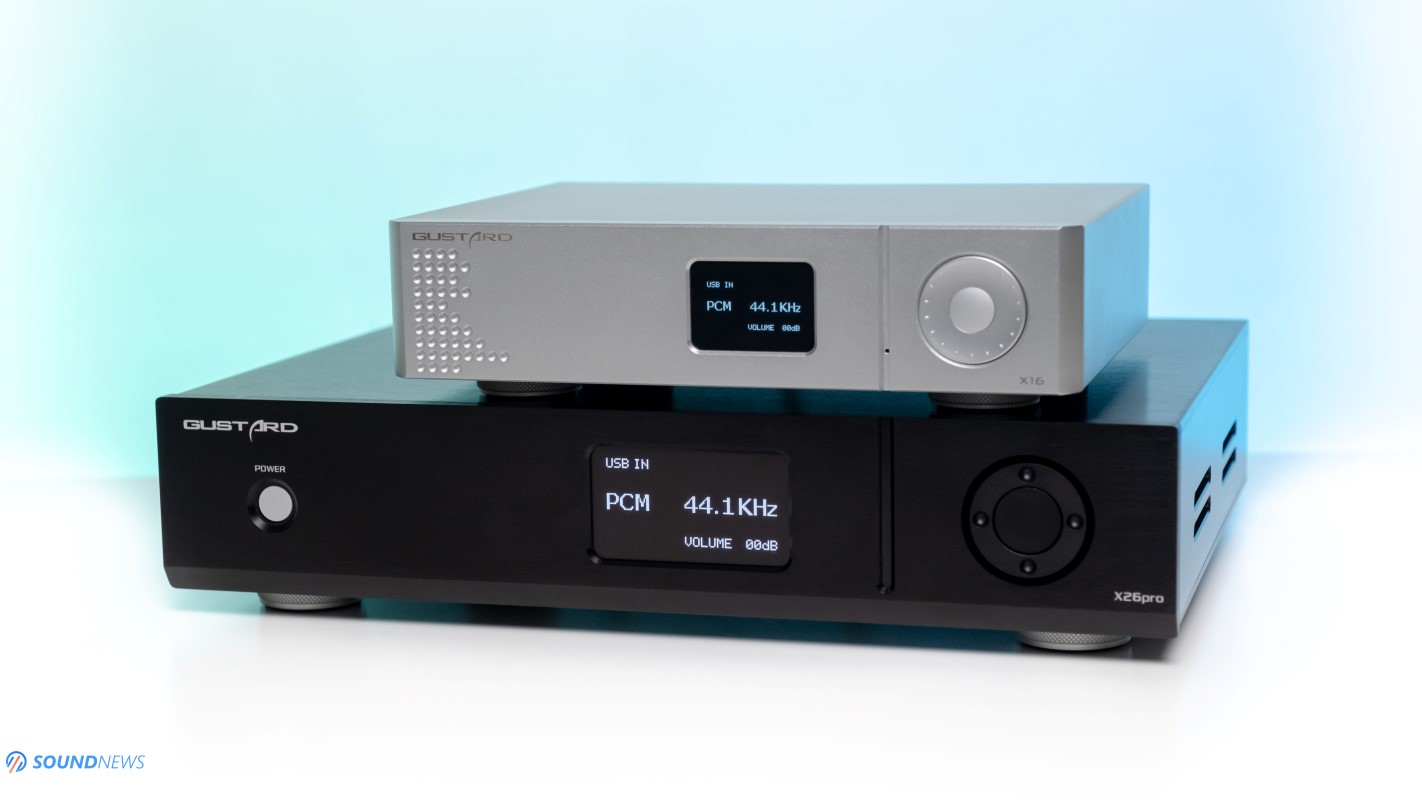
VIII. A Comparison
I know a lot of you are wondering how X16 compares to the best Gustard has ever made, so let’s get it done.
Gustard X16 ($499) VS Gustard X26 PRO ($1499)
In terms of design cues, X16 looks like a smaller and cuter X26 PRO, they look almost identical to me, both use thick aluminum plates carved on a CNC machine, although X26 PRO uses thicker plates and seems to be built like an actual tank. They use the same metal feet, have almost the same inputs and outputs, with the exception that the bigger guy adds an optical input and a 10 MHz clock input.
Both are hiding the screws for a simple and elegant look. Both units are using monochrome OLED screens, they have the same remotes and pretty much the same accessories (yep, including the must-have MiniCD!). Obviously X26 PRO is much bigger, much heavier, packs a lot more technology, has dual toroidal transformers, a super advanced digital board, plus it always works in full Class-A dissipating a lot more heat. The big guy ditched op-amps for good and you’ll find only discrete components inside it. Its capacitance seems to be overkill, everything is dialed up to eleven. I won’t specify all their specs, as you can check those yourselves, let’s move on to the most important part. Since X26 PRO outputs 5V and X16 only 4V, I volume matched them using a MiniDSP EARS system and a Benchmark HPA4.
For this comparison my weapon of choice was the Hifiman HE1000SE, which seems to be extremely detailed and transparent, more so than my loudspeakers and more so to the Audeze LCD-4, Kennerton Wodan and Erzetich Phobos, so it was natural using some detail-oriented headphones.
All my tests were done blindly with the help of my beloved, that was switching the inputs on the HPA4. The most striking difference is how different their tonalities are. If I would never listen to X26 PRO, I would never call its smaller sibling as lean and almost boring sounding, like it gently presses the brakes when dynamics are going wild. X26 PRO felt like a machine gun with fast executed music, it was loud, it was mean, smelling bad attitude from afar, it had all the bass slam you could possibly desire, while sounding effortless and relaxed at the same time. By comparison X16 was lacking nerve, it didn’t have a bad boy attitude, its dynamics felt strained and its bass slam was lacking impact.
Another striking difference is that I could easier follow the trail of a musical note in busy passages with X26 PRO. There was simply more air around, the whole place felt decompressed and the musical notes had clearer leading edges. Not only the soundstage was bigger, wider and taller, but I could easier focus on anything I wanted, without stressing myself too much. X16 wasn’t that impressive with HPA4, it wasn’t that holographic and it wasn’t that deep and open wide by comparison.
Their frequency response feels pretty much the same, with the exception that big guy has more contrast and saturation, there is more bass, more midrange, more treble and a lot more naturalness can be felt while listening to it. X26 is a dynamics beast, always pressing the gas pedal. X16 is a shier sounding unit, you hear the same frequency response, the same footprint, but with a very different attitude.
On the plus side, if you care for transparency, for detail retrieval, for a clean undistorted sound that lacks any background noise, then both units are more or less the same. I’ve spotted exactly the same micro-details, both were showing an absurd amount of information, both felt like non-forgiving truth tellers.
In a loudspeaker setup, I’ve used the same Benchmark HPA4 that worked as a preamp, sending the signal to a KECES S300 power amplifier and then to a pair of KEF Reference 3 loudspeakers. The difference in scale was even bigger, air traveling around was heavier, everything felt more real and palpable. Bigger guy carried more emotions, it pounded my chest harder, it further expanded the stage like I was listening to a bigger loudspeaker. It shouldn’t be a surprise to anyone that X26 PRO sounds better, but at only a third of its price you are getting almost the same feature set, almost the same technicalities in a less vivid, less emotional, less impactful sounding little package.
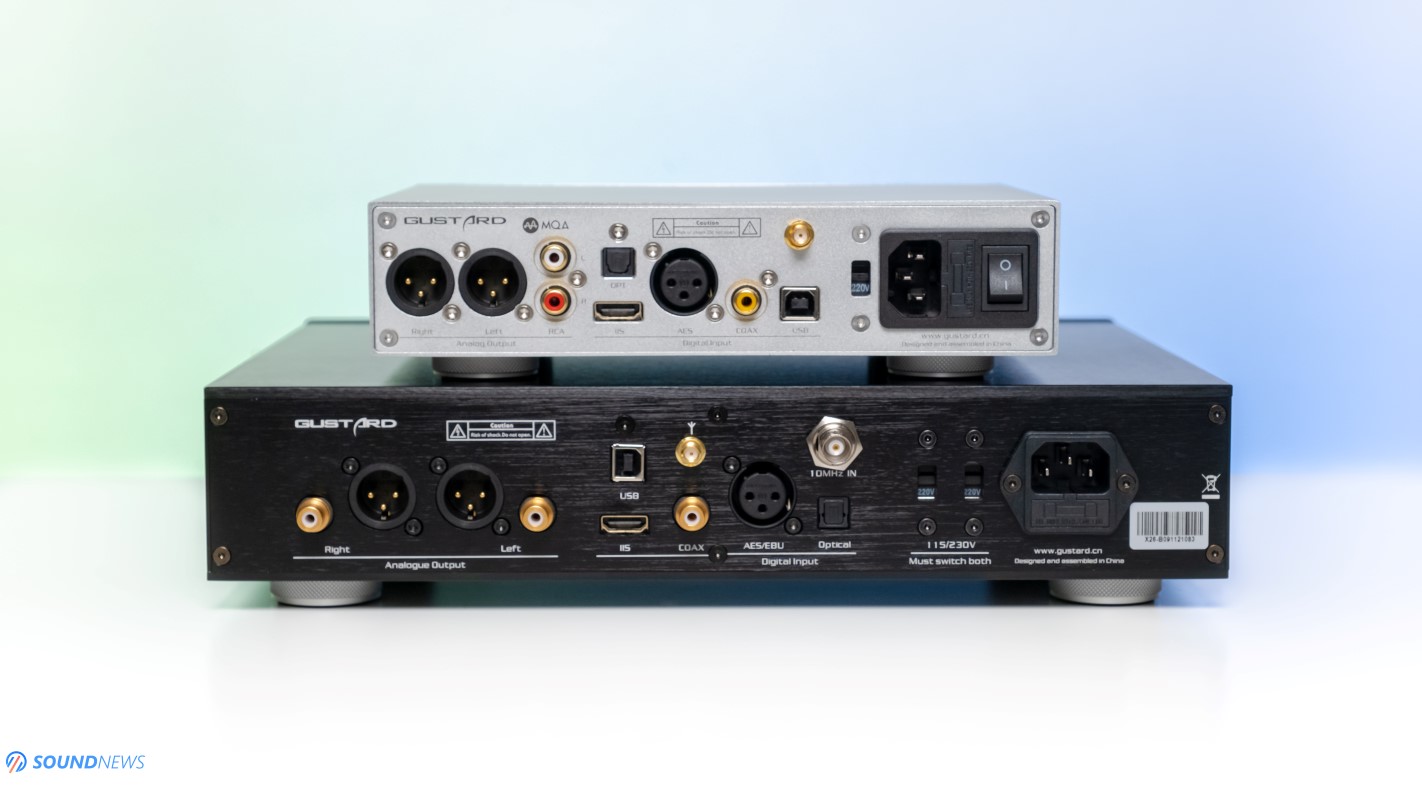
Conclusion
If you are looking for an instrument grade DAC, that is as detailed and transparent as the best converters I’ve tried, that is straight as a line in the frequency response, that will not beautify and sugar coat your music in any way, then X16 seems to be an excellent choice.
It’s fully loaded with a lot of goodies, you get full MQA capabilities, the best Bluetooth codecs are on-board, plus it is a fully balanced DAC and preamplifier that can offer endless possibilities. In my humble opinion it just outperformed its own sibling A18 DAC that I’ve reviewed a while ago, while costing much less. If A18 was on your radar, get the X16 instead! It’s a better unit, it’s more feature packed and it’s more affordable. I’m still scratching my head why Gustard lowered its voltage output and why its matching headphone amplifier has a misaligned screen, but maybe there is something I don’t know, maybe cost and R&D was the biggest defining factor.
Considering its high build quality, its feature set, the newest and the smartest ESS chips and its dual mono design, I consider it a good value at $499. There are still many things that I would do differently in their stead and that is why it gets a Bronze Award.

Gustard X16 was kindly provided by Apos Audio and it can be purchased from their web-store by following this link. (Apos is offering free shipping in the USA and Canada, free 45-day returns in case you don’t like it and an extra year of warranty).
If you get one, please come back and leave a comment, I’m very curious to know how it performs in your headphone or loudspeaker setup! 😉
PROS:
- Minimalist look, great build quality
- Impressive when it comes to features and I/O
- Very detailed and transparent sounding
- Background noise is nowhere to be spotted
- Decent soundstage and depth
- Good pin-point location of the notes
- Linear sound signature, it isn’t putting an accent on a frequency range
- Extended frequency response at both ends of the spectrum
- Great speed and only a decent slam
- Good value at this price point
CONS:
- Not the punchiest sounding DAC
- Not the most vivid and emotional sounding unit
- Soundstage could be better
- Lowering its voltage output from 6V to 4V wasn’t a bright idea
ASSOCIATED EQUIPMENT:
- Sources: Xiaomi Mi 9T Pro, Corsair One i160
- DACs: Gustard X16, Gustard X26 PRO, Matrix Audio Element X, Audiobyte HydraVox + HydraZap, Flux Lab Acoustics FCN-10
- Headphone Amps: Benchmark HPA4, SparkoS Labs Aries, Flux Lab Acoustics FCN-10, SMSL SP400, Burson Soloist 3X, xDuoo XA-10
- Power Amp: KECES S300
- IEMs: FiiO FD5, FA9, FH7, Meze Rai Penta, Rai Solo, LittleDot Cu KIS & many others
- Portable headphones: Sennheiser Momentum 2, Meze 99 Classics
- Full-sized headphones: Hifiman Susvara, Hifiman HE1000SE, Audeze LCD-4, Erzetich Phobos, Erzetich Mania, Kennerton Wodan, Magni, Gjallarhorn, Vali, M12S, Quad ERA-1, Ollo S4X Reference, HarmonicDyne Zeus
- Loudspeakers: KEF Reference 3
- Interconnects: QED Reference (x2), Topping TCX1 (x2)
- Speaker cables: Kimber PR8, Audioquest Type4
- Power Cables: Isotek EVO3 Premier (x3)
- Balanced Isolation Power Conditioners: PLiXiR Elite BAC400
